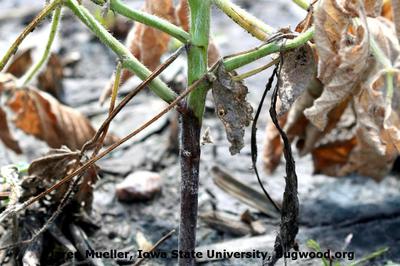Stem and Root Rot of Soybean
Phytophthora sojae
Fungus
In a Nutshell
- infected plants develop characteristic long brown lesions extending from the root to about the middle of the stem.
- Leaves turn yellow and wilt, eventually dying but not falling off the stem.
- Compacted soils, prone to waterlogging, and heavy rains favor the disease.
Can also be found in
Symptoms
At early growth stages, the fungus causes either seed decay or damping-off of seedlings after emergence. At later plant development phases, infected plants develop characteristic long brown lesions that extend from the root to the about the middle of the stem. The damage to the internal tissues of the main root and stem cause leaves to turn yellow and wilt, eventually dying but not falling off the stem. The first symptoms generally appear in compacted soils, prone to waterlogging, one or two weeks after heavy rain. The disease can lead to heavy loss in susceptible cultivars.
Recommendations

Organic Control
No alternative treatment is known to this day against this disease.

Chemical Control
Always consider an integrated approach with preventive measures together with biological treatments if available. Seed treatments with fungicides are the only chemical treatment to control P. sojae. Mefenoxam and metalaxyl can be used as seed treatments. Resistance to these fungicides has been observed in some cases. Soil drenching with copper oxychloride (3g/l of water), often together with a antibiotic (Streptocycline) also work.
What caused it?
Phytophthora sojae is a soil borne pathogen that can survive on plant debris or on seeds for a number of years, even during cold or freezing periods. It can infect plants through the root throughout the season, when conditions are favorable for its development (high soil moisture and optimum temperature of 25 to 30°C). First symptoms usually appear after episodes of heavy rain. The diseased plants seem to be randomly distributed in the field or it can fallow the pattern of low areas or areas with poor drainage.
Preventive Measures
- Buy certified pathogen-free seeds.
- Use resistant or tolerant varieties.
- Improve the drainage of the soil to avoid water-logged areas.



